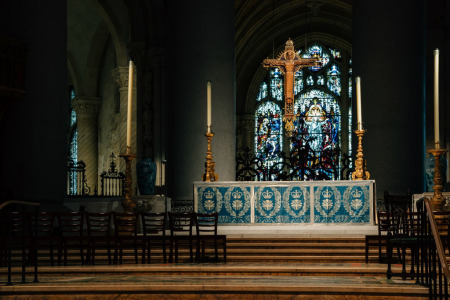Inside the cathedral that almost became a coronavirus field hospital

The Cathedral Church of St. John the Divine in New York City is hardly a typical church or cathedral.
The 121,000-square-foot cathedral, seat of the Episcopal bishop of New York, is the world’s largest cathedral. While there are bigger churches, none are, properly speaking, cathedrals.
It was announced last week that St. John the Divine would host a coronavirus field hospital from neighboring Mount Sinai Morningside Hospital in conjunction with Samaritan’s Purse. However, controversy erupted almost immediately.
The cathedral received significant criticism from the political left — the congregation is unabashedly liberal in its practice of Christianity — for allowing Samaritan’s Purse, run by conservative evangelist Franklin Graham, to use its space.
Within a couple of days, the field hospital closed before it even opened.
All sides say it was no longer needed, thanks to the decline in the number of new coronavirus hospital admissions. That may be the public explanation, but many believe what really happened was a case of deplatforming.
Regardless, anyone interested in historic churches and ecclesiastical architecture should visit St. John the Divine.

The architectural masterpiece is primarily Gothic revival, but a careful read of the edifice reveals elements of Romanesque and Byzantine styles.
The original architects when constructed started in 1892 were George Heins and Christopher LaFarge, who designed a cathedral in the then-fashionable style of Romanesque revival. By 1911, Heins died and the baton passed to acclaimed architect Ralph Adams Cram. He morphed the design into a revival of 13th century French Gothic.
Looking at the exterior the partially complete bell tower is a not so subtle reminder that St. John the Divine should actually be called St. John the Unfinished. However, Cram’s design will almost certainly never be fully realized as the cathedral lacks the millions of dollars required finish construction.
It is also obvious that unlike other churches or cathedrals the Gothic Revival employed here is more than decorative. All the arches and buttresses maintain structural integrity, as no steel or iron were used in construction.
The differing designs become apparent inside with the pointed arches of Gothic giving way to a Byzantine-inspired dome and rounded Romanesque arches beyond the transepts. This is where the nave — many visitors mistakenly call the space where congregants primarily sit the sanctuary — transitions to both the chancel and the actual sanctuary containing the high altar. Rising behind the high altar are gigantic columns that somewhat hide the ambulatory, a semi-circular aisle leading to seven chapels at the far eastern end.
If you go
The Cathedral Church of St. John the Divine is open to visitors Monday through Saturday from 9 a.m. to 5 p.m. Sunday sightseeing hours are more limited. However, the coronavirus pandemic has resulted in a temporary closure.
Admission is $10 for adults and $8 for students and seniors. Several tours, including a behind-the-scenes architectural tour, are available for an extra charge.
Spires and Crosses is a weekly travel column. Follow @dennislennox on Twitter and Instagram.





















